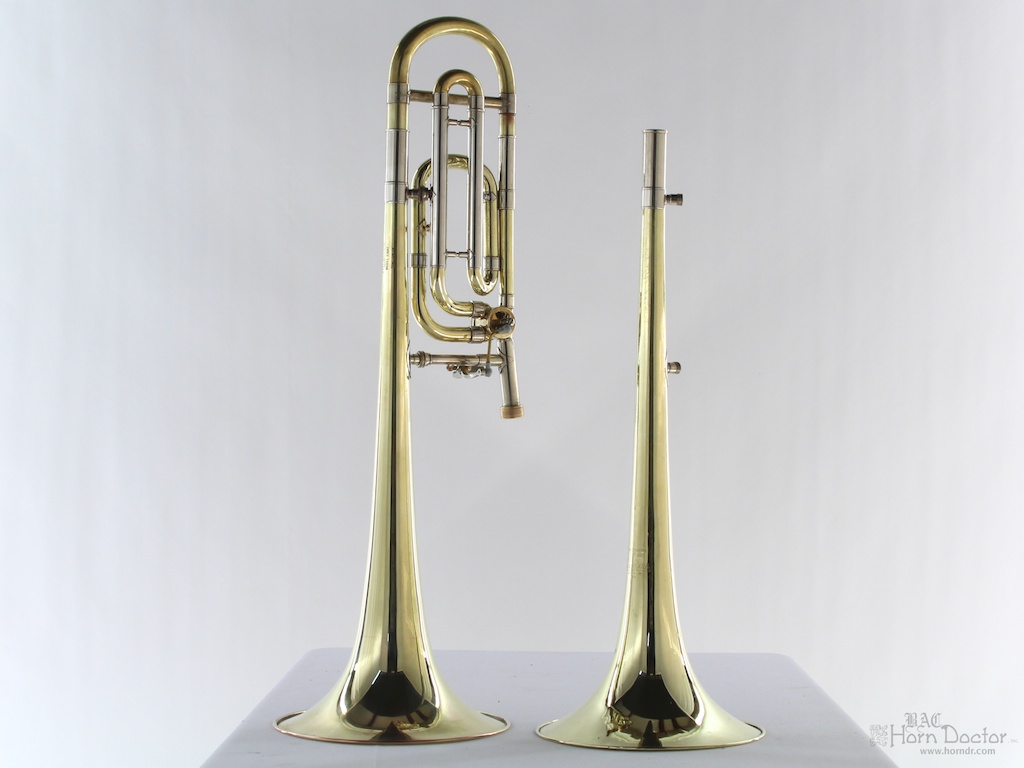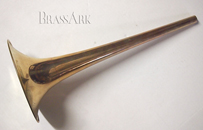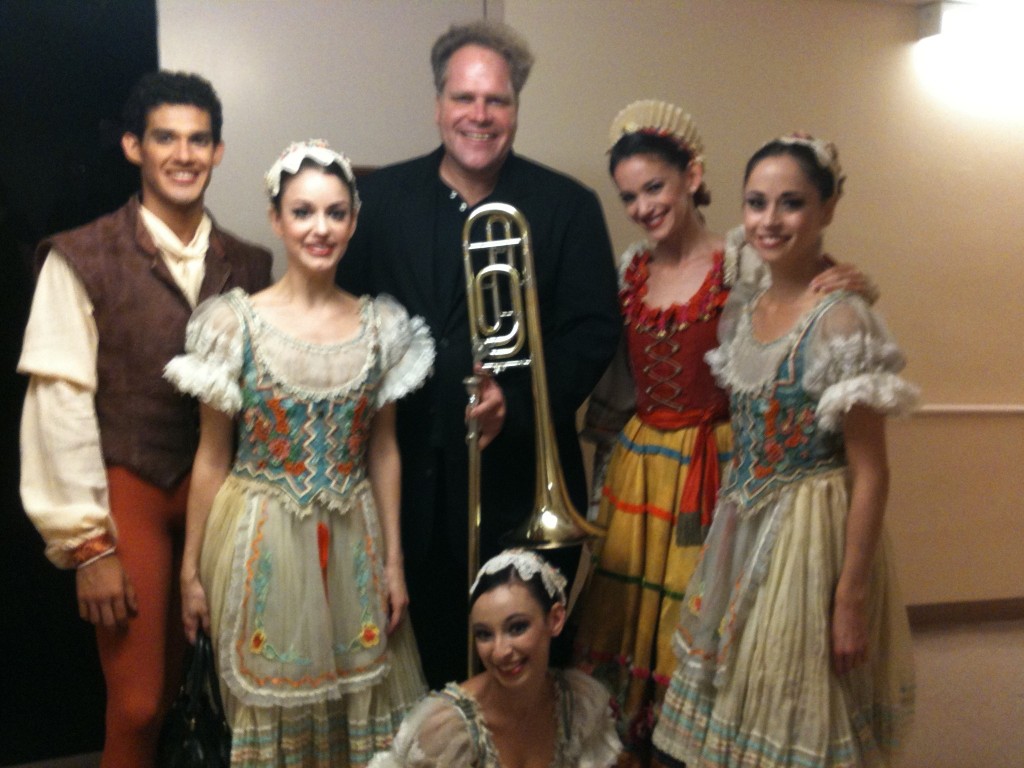An extraordinary opportunity has surfaced to purchase what is believed to be one of only 7 to 9 existing TN Earl Williams Model 8 bells, designated a model 9 if connected to an f-attachment. One of the same stock model 10 bells was recently sold by Noah Gladstone at The Brass Ark, and I was later contacted by someone who had missed the sale. They were offering several times times the asking price of the bell, but none of the model 10 bells are now available. This 8/9 is the same type of bell I have played in the Miami City Ballet Orchestra for the past 5 years and continue to play, but this one has never been mounted. (Of the 7-9 surviving bells, at least four have already been mounted.)
This bell is in the trombone section at Noah Gladstone’s Brass Ark.
Earl William’s company and original tooling was purchased by Jay Armstrong, former principal trombonist in the Nashville Symphony, as the company was re-launched for a brief period of time during the 70’s. Jay himself played on an Earl Williams Model 9-an eight with a trigger. Read Jay’s entire interview here… I have excerpted the most relevant portion below. Enjoy!
The Earl Williams trombone bells are special. Can you comment on any aspects that make them unique? Is the thickness a factor?
We always manufactured the bells to the same ‘thickness’ as Earl did, and we never experimented with “heavier” or “lighter” bells, or bells made of different materials or alloys. Whether ‘thickness’ of bell material is a MAJOR determining factor, I don’t know.
I think the most ‘unique’ factor of the Williams bells are the tapers of the bells, which allow the ‘throat’ to be relatively enlarged. For example, if an EIGHT bell is placed next to a Conn 8 bell, or a Bach 42, the difference of ‘throat size’ (the ‘enlarged’ taper) can easily be seen. Same for all the Williams bells. Each respective model seems ‘larger’ (in the bell) than a competitors instrument. We used a small family-owned company in Elkhart, IN for our bell manufacturing and specified the thickness of the brass to be used. They cut the ‘neck’ patterns using our patterns and their stock. Our bells were difficult for them to ‘work’ because of the thickness. But, we were following the specifications that Earl had made.
than a competitors instrument. We used a small family-owned company in Elkhart, IN for our bell manufacturing and specified the thickness of the brass to be used. They cut the ‘neck’ patterns using our patterns and their stock. Our bells were difficult for them to ‘work’ because of the thickness. But, we were following the specifications that Earl had made.
The bell spinners were true craftsmen. They had a thriving business supplying bells from MANY manufacturers. From the bell spinners, I would return to Nashville with a small quantity of flat ‘neck patterns’, then manually stamp the ‘information’ on the neck, and UPS them back to Elkhart where they were brazed and shaped into rough cones. Several months later I would return to Elkhart with our flare mandrels and ‘final spin’ mandrels, and, within a couple days, I would leave with a couple dozen new bells. Our bell manufacturing process was labor intensive and inefficient. We were a long way from the efficiency one experiences when visiting, for example, Steve Shires’ shop.
I think another important factor in the construction of Williams bells is the use of a ‘bead wire’ and having that wire soldered in place. A soldered wire seems to add a solidity to the overall sound of the bell . . . and from the bell. We built all the Donelson bells with a ‘soldered bead wire’. The ‘bead options’ are (1) no wire, or (2) wire with no solder (risky because one might experience a ‘bell rattle’ on certain notes / harmonics), and (3) bead wire with solder. Option 3 is best (I think); however it takes more ‘labor time’ and adds more ‘complication’ to the finished bell.Our bells always had a nice ‘ring’ to them, and I think part of the reason was because of the soldered bead wire.
Were any bells spun in Tennessee?
All the bells we used in completed instruments were spun by the ‘bell spinner’ in Elkhart. We did spin some bells in TN, but none were of the quality to satisfy us. They were never used and ended up in the trash bin.
What is it about them that makes them so desirable?
For me, the beautiful sound. Big, warm sound from what would seemingly be a ‘small’ horn. A Model Six (.500″ bore) sounds like a much ‘larger’ horn. The Model Four, for example, doesn’t have the ‘brittleness’ that one normally associates with a .490″ horn. The Eight/Nine models sound like .542″ bore horns, though they have a .520″ bore. The Ten has an incredibly large, dark, refined sound.
Did you have knowledge of any special alloy used by Earl?
Earl, to our knowledge, had no ‘special alloys’. He just used “cartridge brass”. A ‘special alloy’ would only be possible in a ‘large’ order of product. Quantity of product was beyond the scope of the relatively small operation of Williams Trombones. (Both for Earl and for us.)
c. 2015 David William Brubeck All Rights Reserved. www.davidbrubeck.com



